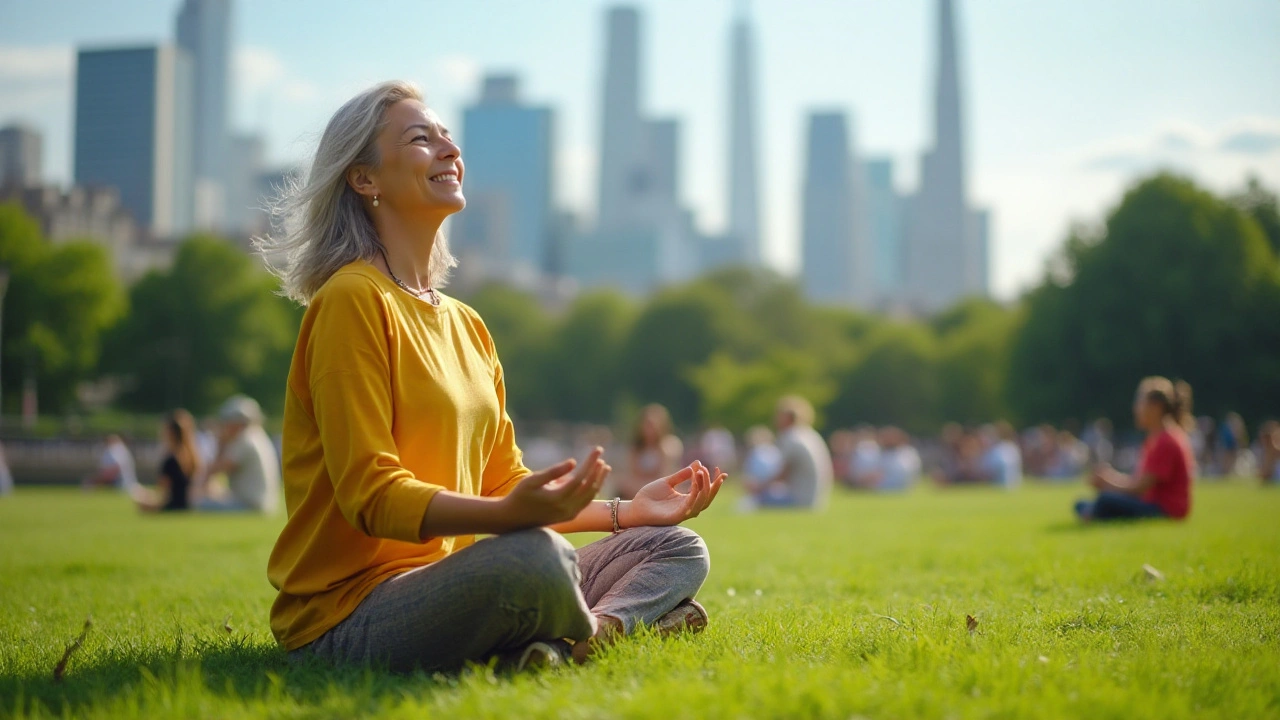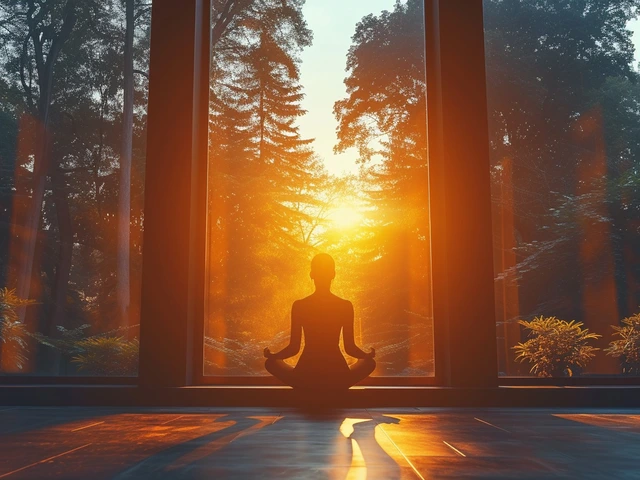Life can get hectic, and finding a moment of peace can sometimes feel impossible. The good news is, you don’t need a spa day or a week-long retreat to relax. There are simple techniques that you can practice anytime and anywhere to help bring a sense of calm to your day.
Whether you're at work, stuck in traffic, or winding down at home, these five relaxation techniques are designed to bring instant relief from stress. Let's dive into some easy yet powerful methods that can help you find your calm amidst the chaos.
Deep Breathing
Deep breathing is one of the simplest yet most effective relaxation techniques you can practice anywhere, anytime. It works by activating your body’s natural relaxation response, lowering stress hormones, and promoting a feeling of calm. When you take slow, deep breaths, you signal to your brain that it’s time to relax, slowing your heart rate and lowering blood pressure.
Let's start with a basic exercise. Sit comfortably with your back straight. Place one hand on your chest and the other on your abdomen. Take a slow, deep breath in through your nose, letting your diaphragm (not your chest) inflate with enough air to create a slight stretch in your lungs. Slowly exhale through your mouth or nose. You'll know you’re doing it right if the hand on your abdomen rises more than the one on your chest.
This technique is so effective that even healthcare professionals recommend it for stress management. Dr. Andrew Weil, a well-known integrative medicine physician, suggests the 4-7-8 breathing technique, which is deeply rooted in yoga. Here’s how to do it:
- Inhale quietly through your nose for 4 seconds.
- Hold your breath for 7 seconds.
- Exhale completely through your mouth, making a whooshing sound, for 8 seconds.
- Repeat this cycle four times.
The science behind deep breathing is fascinating. When you breathe deeply, you increase oxygen supply to your brain, which stimulates the parasympathetic nervous system. This is the system responsible for promoting a state of calm. Deep breathing can even help with symptoms of anxiety and depression.
According to the American Institute of Stress, “Controlled deep breathing can induce the body’s relaxation response, making it one of the best ways to lower stress in the body.”
There are other breathing techniques like Box Breathing and Alternate Nostril Breathing. Box Breathing involves inhaling, holding the breath, exhaling, and pausing, each for a count of four seconds. Alternate Nostril Breathing, often practiced in yoga, involves closing one nostril and breathing through the other, switching sides in a rhythmic pattern. These techniques can be particularly useful during stressful times, whether you're in a busy office or navigating through a challenging day.
The beauty of deep breathing is its simplicity and accessibility. You don’t need any special equipment or a quiet room to practice it. Whether you're in a meeting, driving, or lying down to sleep, deep breathing is a powerful tool to instantly reduce stress and bring about a sense of peace.
Progressive Muscle Relaxation
Progressive Muscle Relaxation (PMR) is a technique that involves tensing and then slowly relaxing each muscle group in your body. This method was developed in the 1930s by American physician Edmund Jacobson as a way to help people cope with anxiety and stress.
To begin, find a quiet and comfortable place where you can sit or lie down without disruptions. Start by taking a few deep breaths to center yourself. Focus on your body and notice if you are holding any tension—maybe in your shoulders or jaw. Begin with your toes, tightening the muscles as much as you can, and then hold for a few seconds before slowly releasing. Notice the contrast between the tension and relaxation.
Gradually work your way up through your body in this manner: your feet, legs, abdomen, chest, arms, and finally your face. Spend about 15 to 20 minutes on the entire process. It's significant to ensure you're not over-tensing, to avoid discomfort or cramps. The goal here is to become acutely aware of how your muscles feel when they are tense and when they are relaxed.
"Progressive Muscle Relaxation can be particularly effective for those who suffer from chronic stress and anxiety," says Dr. Mindy Green, an expert in behavioral health. "It's a grounding technique that helps people become more aware of their body's reaction to stress."
Many people find that practicing PMR before bed can improve sleep quality. By letting go of physical tension, you're also helping to release mental stress, paving the way for a more restful night. According to a study, individuals who practiced PMR had significantly lower levels of cortisol, the stress hormone, after two weeks of daily practice.
Additionally, PMR can be an excellent tool for managing specific stress-related conditions such as headaches, high blood pressure, and digestive issues. If you incorporate this practice into your daily routine, you may find yourself feeling more relaxed and in control, even in the face of life's challenges. For those who may find it difficult at first, guided versions are available through various apps and online resources.
So, if you're searching for a portable relaxation technique, Progressive Muscle Relaxation is a game-changer. You can do it almost anywhere and anytime, making it a versatile and accessible option for stress relief. Whether you are at your desk, waiting in line, or lying in bed, a few minutes of muscle relaxation can make a significant difference in your mental and physical well-being.

Visualization
Visualization is one of those relaxation techniques that can transport you to a place of peace, no matter where you physically are. Imagine you're sitting in heavy traffic or facing a tight deadline at work. Visualization uses the power of your imagination to create a mental escape. This method leverages your brain’s ability to imagine calming and serene scenes that can induce relaxation and reduce stress.
One effective technique involves picturing yourself in a peaceful environment, like a tranquil beach or a quiet forest. Close your eyes, and take a few deep breaths. Now, fill your mind with details: the sound of the waves, the smell of the forest, or the feel of a gentle breeze on your face. Hold this image in your mind and allow yourself to get lost in it for a few minutes. This simple practice can significantly lower your stress levels and restore your sense of calm.
A fascinating aspect of visualization is its measurable benefits on the body. Studies have shown that imagining a peaceful setting can actually lead to physical relaxation. Your heart rate and blood pressure may decrease, and muscle tension can dissipate. This is because the brain often can't tell the difference between a vividly imagined experience and a real one, so it responds as if you are genuinely in that serene place.
Dr. Ellen Langer, a psychology professor at Harvard University, mentions, "Wherever you put your mind, the rest of you will follow." This underscores the power of the mind in creating a state of relaxation.
For those looking for a more structured approach, guided visualizations are also a great option. These are often available as audio recordings and can walk you through a relaxing scene with spoken prompts. Some might guide you through a walk in the mountains, while others might take you on a serene boat trip. This can be particularly helpful for beginners who find it hard to conjure up serene scenes by themselves.
Instant calm can also be achieved through visualization by pairing it with other techniques. For instance, combine visualization with deep breathing for a more powerful effect. As you inhale and exhale slowly, imagine drawing in tranquility and breathing out stress. Repeat this several times while immersing yourself in your mental sanctuary. The combination can accelerate the relaxation process and make it more effective.
Visualization doesn’t require any special tools, making it perfect for busy people. Whether on your lunch break or while waiting for an appointment, a few minutes of visualization can help you reset and recharge. Remember, the key is to make the scenes as vivid as possible. The more details you include, the more effective the technique will be.
So next time you find yourself overwhelmed, take a few moments to practice visualization. Retreat to your mental sanctuary, and let the stress melt away. This simple yet powerful technique is a lifesaver when you need to relax anytime, anywhere.
Mindful Listening
Mindful listening is a potent way to bring a sense of calm and presence into your day, no matter where you are. The essence of this technique lies in paying full attention to the sounds around you. By simply tuning into what you hear, you can anchor yourself to the present moment, easing anxiety and stress.
One easy way to practice mindful listening is to focus on the ambient sounds in your environment. This could be the hum of the air conditioner, the distant chatter of people, or the rustling of leaves in the wind. Close your eyes if possible, and just listen. Allow these sounds to wash over you without judgement. Try to distinguish the different layers of noise, identifying both prominent and subtle sounds. This not only distracts your mind from stress but also cultivates a deeper awareness of your surroundings.
A study by the University of California, Berkeley, found that listening to natural sounds, like the sound of water or birdsong, can significantly lower cortisol levels, the hormone associated with stress. This transformative practice, known as forest therapy or Shinrin-yoku in Japan, is a testament to how powerful mindful listening can be. Even if you're not in a natural setting, you can listen to recordings of nature sounds to achieve a similar effect.
For a more structured approach, consider listening to a piece of music. Choose a song or a piece with different instruments and layers. Focus on each element – the melody, harmony, rhythm, and lyrics, if there are any. If your mind starts to wander, gently bring your focus back to the music. This technique not only helps you relax but also enhances your appreciation for the music itself. As musician John Cage once said,
"Music is a means of rapid transportation."
Mindful listening can also be a profound experience when interacting with others. During conversations, strive to listen without planning your response. Pay attention to the speaker’s words, tone, and emotions. Acknowledge what they say with nods or verbal affirmations. This not only strengthens your relationships but can also make you feel more connected and grounded.
Incorporating mindful listening into your daily routine doesn't require much time or effort, but the benefits can be far-reaching. Whether you are walking in the park, commuting to work, or simply taking a break, allow yourself moments to pause and truly listen. The world has a rich soundscape waiting to be discovered, and tapping into this can be your secret weapon in managing stress and achieving instant calm.
To start practicing, find a quiet spot or use headphones if you're in a noisy environment. Set a timer for five minutes and immerse yourself in the sounds around you. Over time, you can increase the duration as you become more comfortable with the practice. Mindful listening might seem simple, but its impact on your well-being can be profound.

Portable Yoga Poses
Yoga has been practiced for thousands of years and has stood the test of time for good reason. It's a fantastic way to relieve stress and improve your mental and physical well-being. But you don't need a mat or a quiet studio to benefit from yoga. There are several portable yoga poses that you can perform practically anywhere.
One of the most effective poses you can do is the





